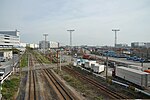Oi Hockey Stadium
2019 establishments in JapanField hockey venues in JapanOlympic field hockey venuesShinagawaSports venues completed in 2019 ... and 2 more
Sports venues in TokyoVenues of the 2020 Summer Olympics

The Oi Hockey Stadium (Japanese: 大井ホッケー競技場, Ōi hokkē kyōgijō) is a Japanese field hockey stadium built on the occasion of the 2020 Summer Olympics in Tokyo. It was inaugurated on August 17, 2019. The stadium is located in the Ōi Futō Chūō Kaihin Park in the Shinagawa district and has a capacity of 15,000 spectators.During the construction of the playing field, attention was paid to sustainability. The synthetic turf on the site is Poligras Tokyo GT, a product of the Sport Group that also produces AstroTurf. The mat consists of sixty percent sugar cane, and needs two-thirds less water than is usual for wetting hockey fields.
Excerpt from the Wikipedia article Oi Hockey Stadium (License: CC BY-SA 3.0, Authors, Images).Oi Hockey Stadium
Tokyo Wangan Road, Shinagawa
Geographical coordinates (GPS) Address Nearby Places Show on map
Geographical coordinates (GPS)
| Latitude | Longitude |
|---|---|
| N 35.592764 ° | E 139.753675 ° |
Address
ホッケー競技場メインピッチ
Tokyo Wangan Road
140-0003 Shinagawa
Japan
Open on Google Maps











